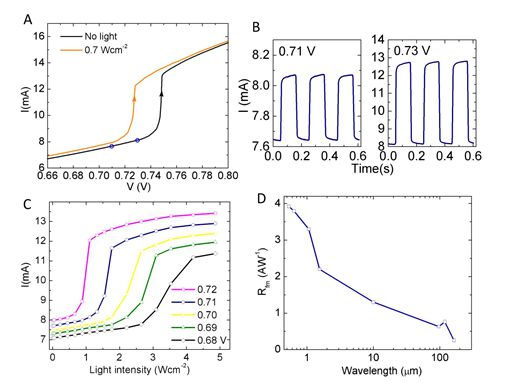[ China Instrument Network Instrument Development ] Recently, Dr. Wu Dong and his colleagues from the Wang Nanlin Research Group at the Center for Quantum Materials Science, Peking University, made a groundbreaking discovery regarding the ultra-wide spectral photoelectric response of 1T-TaS2, a two-dimensional charge-density wave (CDW) material, under room-temperature conditions. Their research focused on the near-commensurate CDW state of 1T-TaS2 and revealed that when the applied electric field is close to the threshold for CDW slip, the material becomes highly sensitive to light across a broad spectrum, ranging from visible to terahertz wavelengths. This finding opens new possibilities for developing uncooled, ultra-wideband photodetectors, including those capable of detecting terahertz radiation. The study was published in *Science Advances* as a Research Article (DOI: 10.1126/sciadv.aao3057, 2018). Wu Dong and Wang Nanlin are co-authors of this work.

Fig. 1T-TaS2 Ultra-wide spectrum photoelectric response characteristics. A. The effect of illumination on the IV curve. B. Switching effect of photocurrent. C. Photocurrent response of the device at λ = 1550 nm under different bias voltages. D. The magnitude of the optical responsivity (R) of the different bands near the threshold voltage.
The ability to convert optical signals into electrical signals is crucial in photonics, with applications spanning imaging, communication, quantum information, and even space science. However, achieving ultra-wide spectral detection—especially covering far-infrared and terahertz ranges—has long been a challenge. Conventional semiconductors, such as silicon, rely on single-particle excitation through their band gap, making them transparent to light below that energy, like terahertz or far-infrared. Metals, while having no band gap, often have too many free carriers, which can shield any photoexcitation signal, making them unsuitable for photodetection. In general, both metals and semiconductors exhibit single-particle excitation behavior.
In contrast, materials with special states like superconductors or charge density waves support not only single-particle but also collective excitations. Charge density waves (CDWs) are one of the most studied collective phenomena in solid-state physics. They have two main excitation modes: amplitude mode and phase mode. The amplitude mode involves a change in the CDW's density, similar to an optical phonon, and doesn't directly affect charge transport. The phase mode corresponds to the overall movement of the CDW, leading to charge flow. In ideal conditions without defects, this motion should be resistance-free. However, in real materials, impurities and defects pin the CDW, limiting its movement. When the applied electric field exceeds the threshold, the CDW slips, causing a sharp drop in resistance.
1T-TaS2 is a well-known 2D CDW material with rich phase behavior due to electron interactions and electron-phonon coupling. As temperature decreases, it transitions from a simple metal to a non-commensurate CDW phase (~550K), then to a near-commensurate CDW phase (~350K), and finally to a commensurate insulating CDW phase (<183K). The electrical properties of 1T-TaS2 show strong nonlinear responses to applied electric fields. Wu Dong and his team discovered that when the applied voltage is below the CDW slip threshold, light exposure causes a shift in the resistance state, effectively inducing an early phase mode slip. This results in a large photoelectric response across a wide range of energies—from ultraviolet to terahertz—making it suitable for ultra-broadband photodetection devices.
Collaborators included Prof. Ma Yongchang from Tianjin University of Technology, Prof. Zhao Ning from Tsinghua University, and researchers from the Critical Research Group at the Center for Quantum Materials Science. The research was supported by the National Natural Science Foundation of China, the National Major Scientific Research Program, and the 2011 Plan Collaborative Innovation Center for Quantum Matter Science.
(Original title: *Science Advances reports Quantum Materials Science Center Wang Nanlin Research Group on the research of ultra-wide-spectrum photoelectric response of charge-density wave materials at room temperature*)
Aluminum Paste For Aerated Concrete
Aluminum powder for AAC,Aluminum powder for concrete block,AAC use aluminum powder,Aluminum powder for ALC Panel
Jiangsu Jiali New Material Technology Co., Ltd. , https://www.jlmaterial.com